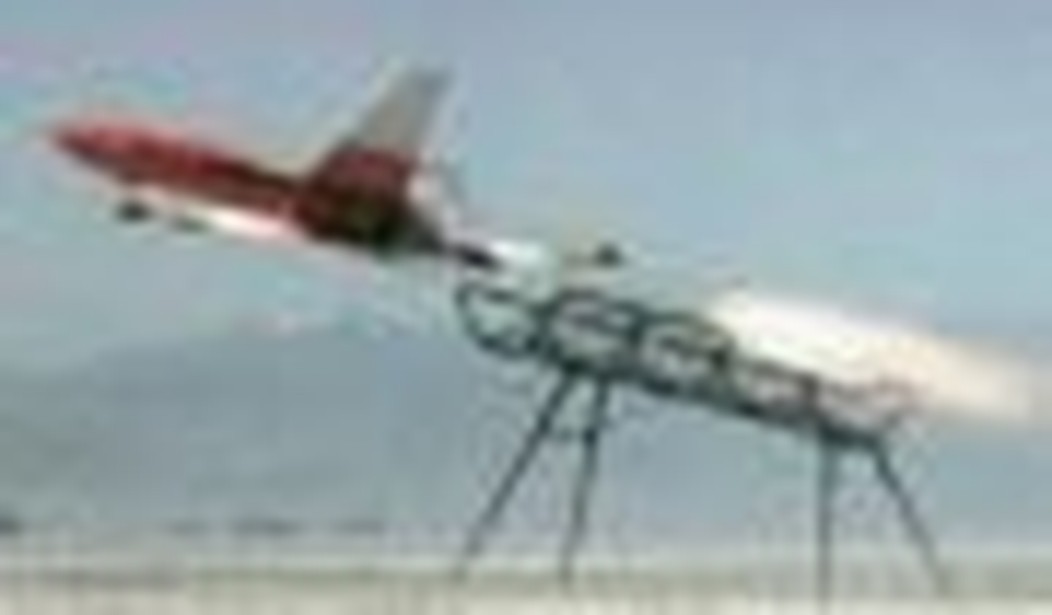Early overtures by the Obama administration to reach out to the Iranian mullahs via President Mahmoud Ahmadinejad are likely to have met their end Monday when it became public that the U.S. shot down an Iranian drone hovering over Iraq — 60 miles north of Baghdad. The shoot-down occurred last month and was first reported by Wired’s Danger Room blog last week, but wasn’t confirmed by a spokesman for the multinational forces in Iraq until Monday.
The suggestion from Iran that the event was “an accident” was immediately put to rest. “This was not an accident on the part of the Iranians,” the military spokesman said, adding, “The [Iranians’] unmanned aerial vehicle was in Iraqi airspace for nearly one hour and 10 minutes and well inside Iraqi territory before” an American fighter jet shot it down.
Iran and Iraq — brutal enemies for decades — are on the same page about the incident. Major General Abdul Aziz Mohammed Jassim, head of military operations at the Iraqi Defense Ministry, told Reuters: “This drone entered Iraq mistakenly at a point 100 km (60 miles) from Baghdad. It crossed 10 km (6 miles) into Iraq. It’s most likely that its entrance (into Iraq) was a mistake.”
Iraq’s Shi’ite Muslim Prime Minister Nuri al-Maliki and Iran’s Shi’ite Muslim President Mahmoud Ahmadinejad are becoming fast friends, leaving President Obama and his administration out in the cold — most likely forced to pick up the pieces of the downed drone under a hail of predictable criticism. This is because the press loves to vilify drones, turning America’s single most effective weapon in the war on terror into an evil, overflying nemesis of the Pakistani people. That the drone is the killer of local hearts and minds. That U.S. drones (also known as UAVs, or unmanned aerial vehicles) are the reason for today’s Pakistani backlash against American military presence in the region.
As it turns out, those reports may in fact be greatly exaggerated. Last week, the Washington Times reported a new poll conducted by a local think tank in tribal areas of western Pakistan which says quite the opposite. Of 550 people interviewed for the study, “60 percent said the drone strikes were effective in damaging terror organizations, and 70 percent would like to see the Pakistan army make its own strikes on the militants.”
The poll was conducted by the Aryana Institute for Regional Research and Advocacy, a foundation made up of scholars, academics, and opinion-makers not funded by the U.S. government. The institute conducts “scientific and rational studies” aimed at informing foreign governments about policy for the region. One of those academics, Ms. Farhat Taj, a native to the area who studies in Scandinavia, told the paper that most locals “viewed al-Qaeda and the Taliban as enemy number one” and want them gone.
“In several places people took up arms against al-Qaeda and the Taliban,” Ms. Taj told the Washington Times. “Pakistan’s army did not help and the leaders of the local people’s armies were killed, one by one or in bulk through suicide bombing.” Apparently, some folks continue to try and resist at the village level, but “the militants have much better weapons and tools of communication than the local people.”
But what about that Iranian drone, which is sure to draw regional Iranian “ire”? What exactly was it doing hovering over Iraq near Baghdad? Spying? Yes. For future weapons strikes? It may be so. In 2006, the Iranian UAV, called the Ababil-3, was supplied by Iran to Hezbollah for use in its war with Israel; both sides used drones. Reporting on the issue in August 2006 for Defense-Aerospace.com, correspondent Ben Moores said that at least two of Hezbollah’s UAVs, both shot down before entering Israeli airspace, were “according to some sources … carrying bomb loads.”
This is the U.S. military’s worst nightmare. A stealthy, low-flying craft equipped with weapons, piloted by the hands of terrorists, be they from the Taliban, al-Qaeda, Hezbollah, or the Islamic Republic of Iran.
Want to read more about the CIA’s first stealth drone, built in Burbank, California, circa 1960? Read Annie Jacobsen’s “What Plane?” in the March issue of the Los Angeles Times Magazine.









Join the conversation as a VIP Member